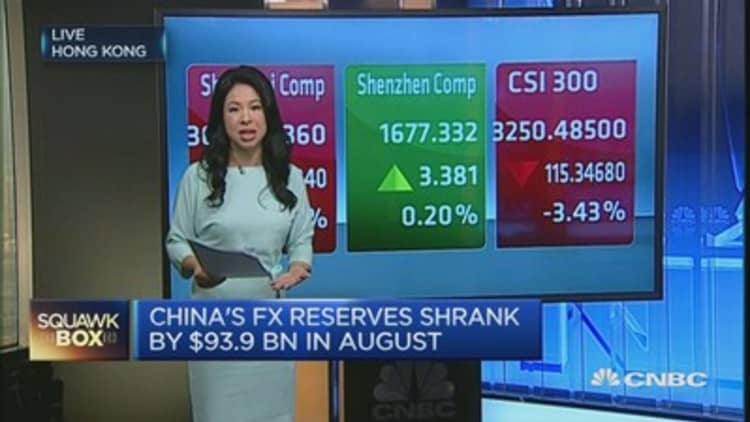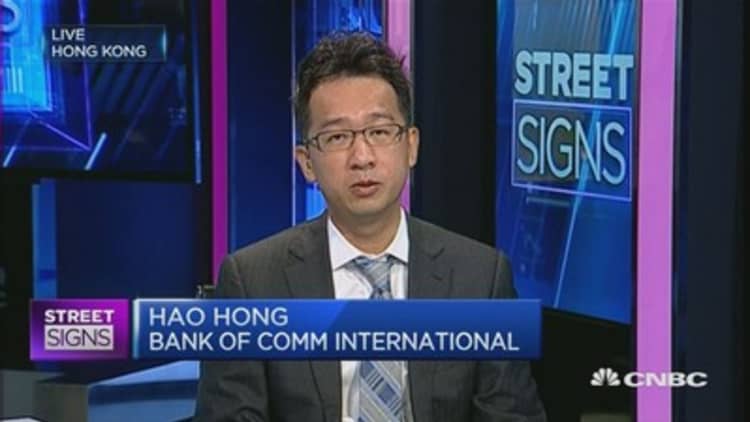
China's shares had a torrid start to the new year with the Shanghai Composite tumbled 6.85 percent to 3296.66 and the Shenzhen Composite plunged 8.1 percent. The CSI 300 briefly plummeted 7.02 percent; when that index rises or falls 7 percent, a trading halt in China's markets is triggered for the rest of the session.
Regulators announced the latest step in its attempts to tame the wild gyrations in its stock markets back in September and was introduced for the first time Monday
Here is what you need to know:
What is a circuit breaker?
A circuit breaker refers to measures put in place to avert panic in markets by putting temporary halts or a freeze in trading if, for instance, the index in question falls by a pre-determined level.
Read MoreU.S. circuit breakers explained
How will the circuit breaker work in China?
The proposed mechanism will be tied to the benchmark CSI300 Index, which tracks the largest listed companies in Shanghai and Shenzhen, where a move of 5 percent in either direction from the index's previous close will trigger a 30-minute trade suspension across the country's equity indexes if the move occurs before 2.30 pm local time. After that, a 5 percent move will freeze trading until the market close at 3.00 pm.
Meanwhile, a 7 percent rise or fall in the CSI300 Index will prompt a trading halt in the Shanghai and Shenzhen stock exchanges for the rest of the day, the statement posted on the exchange's website said. Both circuit breakers will only be activated once a day.
How do things work currently?
Under current rules, individual stocks and index futures are allowed to move a daily maximum of 10 percent from the previous closing level in either direction. Trading of a stock stops when it hits the daily trading limit.
Why is the Shanghai Stock Exchange doing it?
"The circuit breakers are required for movements in both directions to suppress excessive trading and control market volatility. With domestic markets still in the emerging stages and traders mainly made up of small retail investors, huge share price movements in either direction will lead to panic downward spirals or rapid rises," the statement said.
"Hence, when there are explosive increases on the markets, circuit breakers will be needed to stabilize market exuberance, prevent investors from overreacting and give them more time to evaluate whether current share prices are reasonable. " the exchanges added.
The CSI300 Index has been chosen due to its wider representation of large companies and stocks listed in both bourses, compared with the CSI Smallcap 500 Index, according to the statement issued late Monday.
What do traders think?
Market participants have until September 21 to give feedback on the proposal.
However, Hao Hong, MD of research & chief strategist at Bank of Communications International, told CNBC that the proposal contradicts with the current trading limits imposed on the mainland's equity markets.
"If you have a circuit breaker, you don't need the 10 percent daily trading limits anymore and vice versa. You can imagine such a situation when the market opens down 7 percent like a few weeks ago, then the full-day trading will be halted and that would create even more selling pressure the next day. So, I would say it is a very strange rule to introduce to the market," Hong said.

What else have Chinese authorities done to curb volatility?
The announcement comes on the back of a pledge by the China Securities Regulatory Commission (CSRC) on Sunday to take more steps toensure stability in its markets, following whirlwind rides that have taken a toll on market confidence. As of late, authorities have rolled out tighter rules over stock-index futures trading and penalized three firms that run stock trading platforms.
However, the volley of unprecedented measures has thus far fallen short of resuscitating the mainland's equity markets, which have plummeted nearly 40 percent since its mid-June peak. On Monday, the benchmark closed down 2.55 percent in yet another typical volatile session following a four-day long weekend.
*Note: The draft proposals were later revised. A move of 5 percent in either direction from the CSI300index's previous close will now trigger a 15-minute trade suspension across the country's equity indexes if the move occurs before 2.30 pm local time. After that, a 5 percent move will freeze trading until the market close at 3.00 pm. A 7 percent rise or fall in the CSI300 Index will still prompt a trading halt in the Shanghai and Shenzhen stock exchanges for the rest of the day

